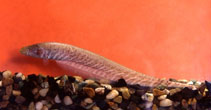Adicionar as suas observações no Fish WatcherAquaMaps webservice down at the moment
Adicionar o seu Fotografias e vídeos
Pictures | Imagem do GoogleGymnotus carapo
Picture by Landines, M.
Pictures | Imagem do GoogleGymnotus carapo
Picture by Landines, M.
Classificação / Names Nomes comuns | Sinónimos | Catalog of Fishes(Género, Espécies) | ITIS | CoL | WoRMS | Cloffa
> Gymnotiformes (Knifefishes) > Gymnotidae (Naked-back knifefishes) > Gymnotinae
Etymology: Gymnotus: Greek, gymnos = naked (Ref. 45335).
More on author: Linnaeus.
Etymology: Gymnotus: Greek, gymnos = naked (Ref. 45335).
More on author: Linnaeus.
Environment: milieu / climate zone / depth range / distribution range Ecologia
; Água doce bentopelágico; pH range: 6.0 - 7.5; dH range: ? - 15; potamódromo (Ref. 51243). Subtropical; 22°C - 28°C (Ref. 1672)
Distribuição Países | Áreas FAO | Ecossistemas | Ocorrências | Point map | Introduções | Faunafri
Central and South America: southern Mexico to Paraguay, including Trinidad.
Length at first maturity / Tamanho / Peso / Idade
Maturity: Lm 19.4, range 25 - ? cm
Max length : 76.0 cm TL macho/indeterminado; (Ref. 79585); peso máx. Publicado: 1.2 kg (Ref. 79585)
Max length : 76.0 cm TL macho/indeterminado; (Ref. 79585); peso máx. Publicado: 1.2 kg (Ref. 79585)
Facultative air-breathing (Ref. 126274); Aggressive (Ref. 27188). Inhabits turbid slow moving or standing waters (Ref. 11225). Found also in shallow edges of streams (Ref. 75964). Can survive when ditches, canals and small ponds dry out. (Ref. 11225). Feeds mainly at night on worms, insects (e.g. odonate larvae), shrimps, fish (preferably small characids, e.g. Ctenobrycon and Curimata) and plant matter (Ref. 7020; 10011). Oviparous (Ref. 205). Mouth brooding by males is observed in this species (Ref. 55570). Males provide parental care in nests excavated for eggs and larvae (Ref. 55570). Uses its long anal fin for locomotion. Can distinguish between a `friendly neighbor' and a potentially `threatening stranger' based on electric organ discharge (EOD) waveform alone (Ref. 10011). Relationship between EOD pattern and agonistic behavior in this species has been demonstrated (Refs. 10531, 10532, 10533). Shows auditory abilities, responding best to a frequency of 1000 Hz, with an upper limit above 5000 Hz (Ref. 10831). Also responds to vibratory stimuli (water waves: 125-250 Hz) with transient increase in EOD rate (Ref. 10834). 'Prefers' temperatures of 24-25°C (Ref. 10836).
Life cycle and mating behavior Maturidade | Reprodução | Desova | Ovos | Fecundidade | Larvas
Parental care is provided by the male. The male sits on a depression with its anal fin expanded horizontally guarding a cluster of larvae. More larvae are spread out in leaf litter up to 2 m away (Ref. 55570).
Referência principal
Upload your references | Referências | Coordenador : Campos-da-Paz, Ricardo | Colaboradores
Campos-da-Paz, R., 2003. Gymnotidae (Naked-back knifefishes). p. 483-486. In R.E. Reis, S.O. Kullander and C.J. Ferraris, Jr. (eds.) Checklist of the Freshwater Fishes of South and Central America. Porto Alegre EDIPUCRS, Brasil. (Ref. 36692)
Categoria na Lista Vermelha da IUCN (Ref. 130435: Version 2024-2)
Preocupação menor (LC) ; Date assessed: 09 July 2018
CITES
Not Evaluated
Ameaça para o homem
Harmless
Utilização humana
Pescarias: sem interesse; Aquário: Espécies comerciais
FAO - Publication: search | FishSource |
Mais informação
Population dynamics
Parâmetros de crescimento
Max. ages / sizes
Length-weight rel.
Length-length rel.
Frequência de comprimento
Mass conversion
Recrutamento
Abundância
Parâmetros de crescimento
Max. ages / sizes
Length-weight rel.
Length-length rel.
Frequência de comprimento
Mass conversion
Recrutamento
Abundância
Life cycle
Reprodução
Maturidade
Maturity/Gills rel.
Fecundidade
Desova
Spawning aggregations
Ovos
Desenvolvimento dos ovos
Larvas
Dinâmica larvar
Reprodução
Maturidade
Maturity/Gills rel.
Fecundidade
Desova
Spawning aggregations
Ovos
Desenvolvimento dos ovos
Larvas
Dinâmica larvar
Physiology
Body composition
Nutrients
Consumo de oxigénio
Tipo de natação
Velocidade de natação
Visual pigments
Fish sound
Diseases & Parasites
Toxicity (LC50s)
Body composition
Nutrients
Consumo de oxigénio
Tipo de natação
Velocidade de natação
Visual pigments
Fish sound
Diseases & Parasites
Toxicity (LC50s)
Human related
Aquaculture systems
Perfis para aquacultura
Estirpes
Ciguatera cases
Stamps, coins, misc.
Aquaculture systems
Perfis para aquacultura
Estirpes
Ciguatera cases
Stamps, coins, misc.
Ferramentas
Bio-Quiz | E-book | Guia de campo | Ferramenta auxiliar de frequências de comprimento | Ferramenta sobre a história de vida | Mapa dos pontos | Classification Tree
| Catch-MSY |
Relatórios especiais
Descarregue XML
Fontes da internet
AFORO (otoliths) | Alien/Invasive Species database | Aquatic Commons | BHL | Cloffa | BOLDSystems | Websites from users | Consultar FishWatcher | CISTI | Catalog of Fishes: Género, Espécies | DiscoverLife | ECOTOX | FAO - Publication: search | Faunafri | Fishipedia | Fishtrace | GenBank: genoma, nucleotídeo | GloBI | Google Books | Google Scholar | Google | IGFA World Record | MitoFish | Bases de dados nacionais | Otolith Atlas of Taiwan Fishes | PubMed | Reef Life Survey | Socotra Atlas | Árvore da vida | Wikipedia: ir para, procurar | World Records Freshwater Fishing | Zoobank | Registo zoológico
Estimates based on models
Phylogenetic diversity index (Ref. 82804): PD50 = 0.5000 [Uniqueness, from 0.5 = low to 2.0 = high].
Bayesian length-weight: a=0.00372 (0.00286 - 0.00483), b=2.93 (2.85 - 3.01), in cm total length, based on LWR estimates for this species (Ref. 93245).
Nível Trófico (Ref. 69278): 3.6 ±0.56 se; based on food items.
Generation time: 3.6 ( na - na) years. Estimated as median ln(3)/K based on 2 growth studies.
Resiliência (Ref. 120179): Médio, tempo mínimo de duplicação da população 1,4 - 4,4 anos (tm=2).
Fishing Vulnerability (Ref. 59153): Moderate vulnerability (37 of 100).
Nutrients (Ref. 124155): Calcium = 51.3 [21.6, 112.8] mg/100g; Iron = 0.975 [0.510, 1.782] mg/100g; Protein = 18.3 [17.1, 19.6] %; Omega3 = 0.33 [0.13, 0.83] g/100g; Selenium = 25.6 [9.8, 63.4] μg/100g; VitaminA = 21.8 [6.9, 67.1] μg/100g; Zinc = 1 [1, 1] mg/100g (wet weight);




